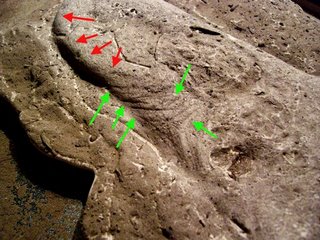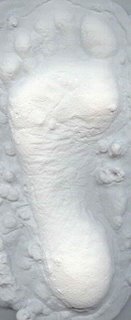Dermal Ridges can happen
 1. Water Heated to 100 Degrees
1. Water Heated to 100 Degrees2. Plaster of Paris mixed thick (just like Matt said to)
3. Plaster poured into the Arch portion of the cast - no splash casting.
3. Air Temperature 75 degrees, Humidity is at 87%
4. Measurement of the Dry Track: 9 inches long by 3 inches wide.
I decided to accept a challenge. Why not go ahead and test the theory of Matt Crowley. If these "Artifacts" (which I call "Crowley lines") will happen in the circumstances he has noted - I should see these Crowley lines in this cast. So. The work began
I poured out a pan full of the Onion Mountain Soil -- First off let me tell you, this soil is just as powdery and lightweight as the Tricalcium Phosophate I used in my first set of experiments - but dont let that fool you. Unlike the Tricalcium Phosphate - I could apply my bodyweight to this soil - heck I could stand on one foot and only get to a maximum depth of about 2 inches. I find this curious.

It may have something to do with the Clay found in the soil (which is one of a few things Volcanic Ash turns into as it breaks down) But lets be very clear about this - if you took this sample to have it analyzed, it would not come back with a reading that says it is Volcanic Ash. Volcanic Ash breaks down very fast - in as little as 2 years if it is exposed to the elements, I was told even faster by a Volcanologist currently working on Mt. Saint Helens for the USGS, if Ash is on the side of a hill, or a Mountain side. I will get into the actual properties of the soil at a later date, as I am waiting for some other very specific information about this soil. I am trying to dot all of my i's and crossing all my t's.

Ok for the pictures. I did exactly what Matt Crowley discusses. My results..I do have Dermal Ridges and Flexion Creases. While the dermals are very faint they are there. The dermals on a human female are much smaller and more difficult to recover than that of a human male. These casts are of my feet - and I am (I guarantee you) a human female.
Measurement of the track prior to casting:
These numbers remained unchanged in the finished cast - there was no expanision.. I can not account for this. I expected to see some expansion - but I had none.
I was unable to duplicate Matt's work. I did exactly as I was instructed, and I could not do it. I have the feeling it may have everything to do with the casting agent. But, something we need to consider is this. Matt's work for the most part was in Volcanic ash - and Im sure that ash moved much easier under the weight of the casting agent. This soil is not the same - at all. If you look at the full foot cast you will  see a depression in the soil (in the arch area) - that is where the casting agent made first contact with the soil - and it abruptly stops. Another thing to consider - soil is not Volcanic Ash. There is a big difference between the two.
see a depression in the soil (in the arch area) - that is where the casting agent made first contact with the soil - and it abruptly stops. Another thing to consider - soil is not Volcanic Ash. There is a big difference between the two.
My work is still ongoing - and if I can answer any questions I will be more than happy to. I will not guess - or make assumptions. I am not saying this is the final word on anything - and I am open to any and all suggestions. I am not doing this to trash Matt Crowley or his work, I just want answers and I want the truth, just as many of you do.
So, I think its pretty safe to say - based on this test: Dermal Ridges and Flexion Creases are possible in the soil from the Logging Road of Onion Mountain.























